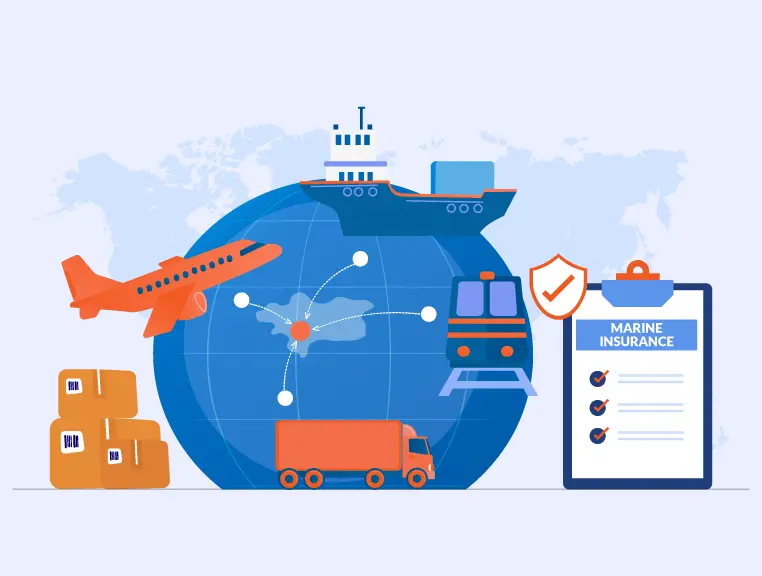Conveyance insurance, also referred to as conveyance marine insurance was highly impacted by the Covid-19 pandemic. This was mainly due to disruptions in global trade and changes in shipping patterns and risks. The pandemic led to widespread disruptions in global supply chains. restrictions on goods movement, port closures, and lockdowns caused rerouting, delays, and also increased risks of loss during transit.
What is conveyance insurance?
Conveyance insurance meaning: It is insurance that protects goods or merchandise in transit against various risks and perils. It covers the cargo being transported from one location to another via sea or other waterways. Conveyance insurance cover includes damage or loss arising due to the sinking of a ship/vessel, theft, fire, collisions, natural disasters like earthquakes or storms, and other perils specific to marine transport.
Conveyance insurance is also referred to as marine cargo insurance. There are various types of policies available that can be customised as per the needs. This includes open cargo policy, voyage policy, and specific cargo policy.
Conveyance insurance post-pandemic: lessons learned and future trends
The marine insurance sector gathered many vital lessons that reshaped their approaches to risk assessment, operational strategies, and coverage offerings. Here are some crucial lessons learned and the future trends:
- The critical importance of resilient supply chains has been a focus post-pandemic. Insurers recognised the need to assess and mitigate risks associated with supply chain disruptions that caused delays, rerouting, and storage problems during transit. In the future, insurers will place greater emphasis on risk management tools that improve supply chain resilience.
- Insurers understood the need to craft conveyance insurance policies that can adapt to unforeseen circumstances such as pandemic situations.
- Insurers revamped their risk assessment models to incorporate pandemic-related risks into their calculations. There is also a change in how the insurance company conveys its acceptance of the proposal.
- Insurance companies learned the need to reevaluate their claims management processes due to increased claim volumes during the pandemic. Remodelling the efficiency of claims handling became a priority.
- The reliance on digital tools and remote services increased post-pandemic. Insurers have started to leverage technology for streamlined processes, such as online policy issuance, digital claims processing, and virtual risk assessments. With increased reliance on digital platforms, conveyance insurance might integrate coverage for data breaches, cyber-attacks, and other digital threats associated with online transactions.
- Insurers realised the importance of educating clients about their coverage, potential risks, and policy limitations. Clear communication helps clients make informed decisions and understand the extent of their protection.
- Insurers and clients gained a clearer understanding of policy exclusions related to pandemics. There is a greater focus on clearly defining coverage for pandemic-related risks or exclusions to manage expectations and avoid disputes.
- Heightened awareness of regulatory changes and their impact on international trade and shipping prompted insurers to closely monitor and adapt policies to comply with evolving regulations.
The impact of the pandemic – future trends
In the future, Insurers will continue to refine risk assessment models using advanced data analytics. This involves leveraging new technologies like artificial intelligence, big data, and predictive modelling to anticipate the risks and manage them effectively. The digital transformation of insurance processes will continue, with further advancements in online policy issuance, claims processing, and risk assessment. Insurers will prioritise efficiency and convenience through digital platforms.
Insurers will continue to offer more tailored policies that meet specific client needs. Customisable coverage options and adaptable policies that can respond to changing cargo types and values will likely become more common. As regulations evolve, insurers will stay vigilant to ensure compliance and adjust policies accordingly.
Conclusion
The pandemic has brought transformation in conveyance insurance. Lessons learned emphasise adaptability, resilience, and innovation within the marine insurance sector. Moreover, the future of conveyance marine insurance post-pandemic will likely revolve around adapting to new risks, leveraging technology for better risk assessment and customer service, and fostering resilience in supply chains against various disruptions.
About The Author
Simran
MBA Insurance and Risk
With extensive experience in the insurance industry, Simran is a seasoned writer specializing in articles on marine insurance for SecureNow. Drawing from 5 years of expertise in the field, she possesses a comprehensive understanding of the complexities and nuances of marine insurance policies. Her articles offer valuable insights into various aspects of marine insurance, including cargo protection, hull insurance, and liability coverage for marine-related risks. Renowned for their insightful analysis and informative content, Simran is committed to providing readers with actionable information that helps them navigate the intricacies of marine insurance with confidence.




